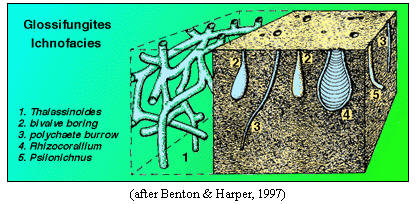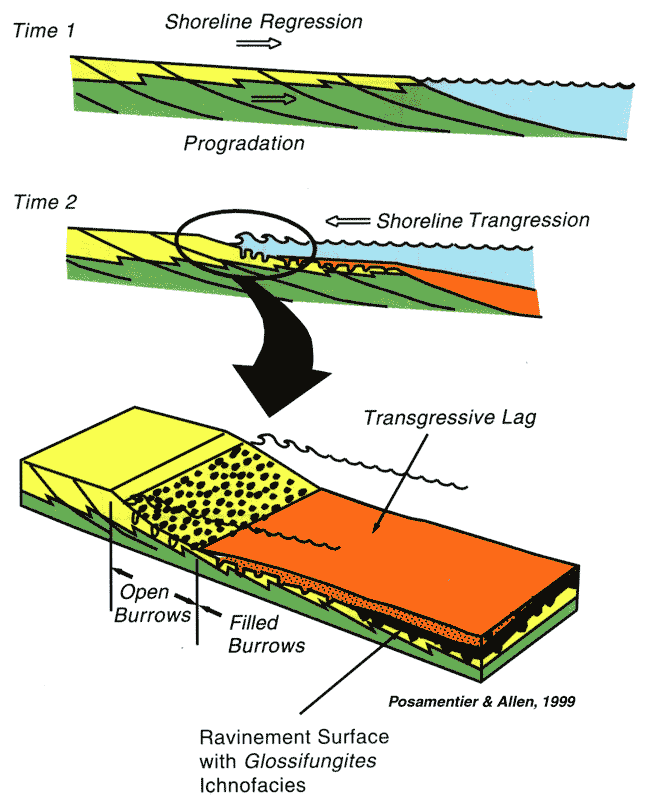|

bedding plane
boundaries bounding surfaces
glossifungites
Ichnology Literature
lowstand systems tract
marine flooding surface
maximum flooding surface (mfs)
parasequence
parasequence - clastic beach
parasequence set
progradation
progradational parasequence set
shoreline
sequence
ravinement
regression
regressive surface of erosion
trangressive surface
trangressive systems tract
Walther's Law
|
A firm ground is formed by a stiff but uncemented carbonate and/or clastic sediment that, at one time, was close to the sediment water interface (Droser et al 2002). In Holocene settings firm grounds tend to be exposed at the sediment water interface after the overlying layers of unconsolidated soft sediment have been eroded. This erosive surface may be one origin of bedding planes. The firm conditions exhibited by a sediment are usually the result of dewatering and compaction. When carbonate or clastic silty to muddy sediments accumulate in the absence of bioturbators, they tend to de-water rapidly. With the erosion of the overlying softer sediment, this process of compaction alone will tend to result in the exposure of a cohesive sediment surface. The character of the sedimentary structures, particularly glossifungites burrows that formed close to the sediment–water interface are used to identify the setting in which firm grounds were formed.
The erosive ravinement associated with transgressive surfaces is developed with the onset of a sea level rise across a sediment suface over a lowstand system tract which may expose these firm grounds that become the site of colonization by the organisms that collectively burrow the surface to form the glossifungites ichnofacies. Examples of these firm ground surfaces include the transgressive surfaces formed just below the maximum flooding surfaces marking parasequence boundaries. It should be recognized that, as Pemberton and MacEachern (1995) explain, that the maximum flooding surface is associated with anoxic conditions and has not been recognized as burrowed. Any burrowing is likely associated with the underlying transgressive event!
The glossifungites facies are an ichnofacies which represents an assemblage of burrows (vertical, U-shaped, or sparsely branched) that occur in firm, but not lithified siliciclastic and/or carbonate muds and silts of the intertidal and shallow marine where scouring has often removed the unconsolidated layers at the sediment surface. The surfaces on which glossifungites occur are interpreted to have formed following a regression and sea level fall and just after the inital transgressive phase immediately following sea level lowstands. At these discontinuity surfaces sedimentation appears to have temporally ceased, and erosion has occured. Examples of these surface include the transgressive surfaces formed just below the maximum flooding surfaces of parasequence boundaries.

The image above from University College of London course on trace fossils).
The above photograph of a ravinement surface penetrated by glossifungites in the Cretaceous prograding shoreline at the Book Cliffs in Utah. Photograph by Janiel Rivera in 2002.

Link to the Ichnology Research Group (IRG) at the University of Alberta, Edmonton, Canada web site logo to the left for a more complete description of this and other ichnofacies.
References (See also Link to Ichnology Literature to left)
Mary L. Droser, Soren Jensen, and James G. Gehling, 2002, Trace Fossils and substrates of the terminal Proterozoic–Cambrian transition: Implications for the record of early bilaterians and sediment mixing;Geologys, October 1, vol. 99 no. 20 p12573
Pemberton, S.G. and MacEachern, J.A. 1995. The Sequence stratigraphic significance of Trace Fossils in examples from the Cretaceous of Alberta. In: Van Wagoner, J.A., and Bertram, G.T. (eds.). Sequence Stratigraphy of Foreland Basin Deposits - Outcrop and Subsurface Examples from the Cretaceous of North America. American Association of Petroleum Geologists Memoir, 64: 429-475.
|